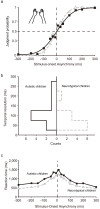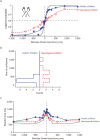Spatio-temporal processing of tactile stimuli in autistic children
- PMID: 25100146
- PMCID: PMC4124471
- DOI: 10.1038/srep05985
Spatio-temporal processing of tactile stimuli in autistic children
Abstract
Altered multisensory integration has been reported in autism; however, little is known concerning how the autistic brain processes spatio-temporal information concerning tactile stimuli. We report a study in which a crossed-hands illusion was investigated in autistic children. Neurotypical individuals often experience a subjective reversal of temporal order judgments when their hands are stimulated while crossed, and the illusion is known to be acquired in early childhood. However, under those conditions where the somatotopic representation is given priority over the actual spatial location of the hands, such reversals may not occur. Here, we showed that a significantly smaller illusory reversal was demonstrated in autistic children than in neurotypical children. Furthermore, in an additional experiment, the young boys who had higher Autism Spectrum Quotient (AQ) scores generally showed a smaller crossed hands deficit. These results suggest that rudimentary spatio-temporal processing of tactile stimuli exists in autistic children, and the altered processing may interfere with the development of an external frame of reference in real-life situations.
Figures






Similar articles
-
Crossing the hands increases illusory self-touch.PLoS One. 2014 Apr 3;9(4):e94008. doi: 10.1371/journal.pone.0094008. eCollection 2014. PLoS One. 2014. PMID: 24699795 Free PMC article.
-
Visual and Proprioceptive Influences on Tactile Spatial Processing in Adults with Autism Spectrum Disorders.Autism Res. 2019 Dec;12(12):1745-1757. doi: 10.1002/aur.2202. Epub 2019 Sep 11. Autism Res. 2019. PMID: 31507084
-
Flexibly weighted integration of tactile reference frames.Neuropsychologia. 2015 Apr;70:367-74. doi: 10.1016/j.neuropsychologia.2014.10.001. Epub 2014 Oct 19. Neuropsychologia. 2015. PMID: 25447059
-
[Temporal and spatial representations of tactile sensation].Brain Nerve. 2014 Apr;66(4):329-39. Brain Nerve. 2014. PMID: 24748080 Review. Japanese.
-
Sensory processing in autism: a review of neurophysiologic findings.Pediatr Res. 2011 May;69(5 Pt 2):48R-54R. doi: 10.1203/PDR.0b013e3182130c54. Pediatr Res. 2011. PMID: 21289533 Free PMC article. Review.
Cited by
-
Spatiotemporal processing of somatosensory stimuli in schizotypy.Sci Rep. 2016 Dec 9;6:38735. doi: 10.1038/srep38735. Sci Rep. 2016. PMID: 27934937 Free PMC article.
-
Weakened Bayesian Calibration for Tactile Temporal Order Judgment in Individuals with Higher Autistic Traits.J Autism Dev Disord. 2023 Jan;53(1):378-389. doi: 10.1007/s10803-022-05442-0. Epub 2022 Jan 22. J Autism Dev Disord. 2023. PMID: 35064873 Free PMC article.
-
Behavioral, perceptual, and neural alterations in sensory and multisensory function in autism spectrum disorder.Prog Neurobiol. 2015 Nov;134:140-60. doi: 10.1016/j.pneurobio.2015.09.007. Epub 2015 Oct 9. Prog Neurobiol. 2015. PMID: 26455789 Free PMC article. Review.
-
Investigating visual-tactile interactions over time and space in adults with autism.J Autism Dev Disord. 2015 Oct;45(10):3316-26. doi: 10.1007/s10803-015-2492-8. J Autism Dev Disord. 2015. PMID: 26063447
-
Higher Tactile Temporal Resolution as a Basis of Hypersensitivity in Individuals with Autism Spectrum Disorder.J Autism Dev Disord. 2019 Jan;49(1):44-53. doi: 10.1007/s10803-018-3677-8. J Autism Dev Disord. 2019. PMID: 30019275 Free PMC article.
References
-
- Volkmar F. R. & Pauls D. Autism. Lancet 362, 1133–1141 (2003). - PubMed
-
- Geschwind D. H. & Levitt P. Autism spectrum disorders: developmental disconnection syndromes. Curr Opin Neurobiol 17, 103–111 (2007). - PubMed
-
- Rizzolatti G. & Fabbri-Destro M. Mirror neurons: from discovery to autism. Exp Brain Res 200, 223–237 (2010). - PubMed
-
- Baron-Cohen S., Leslie A. M. & Frith U. Does the autistic child have a “theory of mind”? Cognition 21, 37–46 (1985). - PubMed
Publication types
MeSH terms
LinkOut - more resources
Full Text Sources
Other Literature Sources

